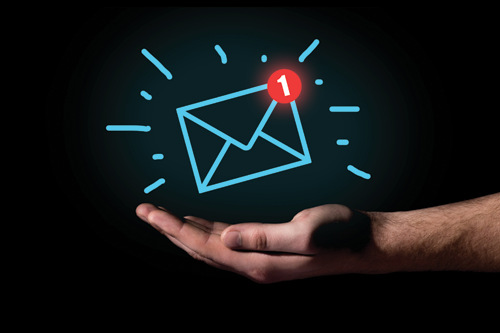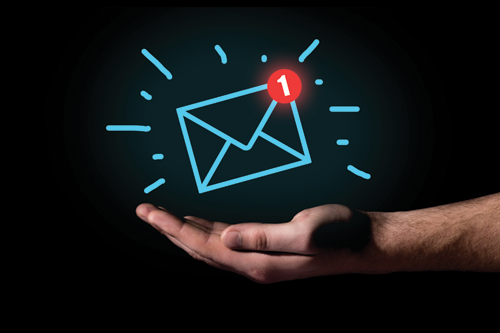By: Joshua Bolkan
Email is a great way to reach one customer or prospect at a time. Because they get to decide what they click on and when, anyone who opens your email is by definition ready to hear your message.

But once you’ve decided to put your thoughtfully chosen mailing list to work and share your helpful insights or other valuable information, it can be tough to get the words flowing. I’ve found that focusing on the nuts and bolts is the best way to get those creative gears greased.
- Ask yourself three key questions.
The first question to ask before you rev up your word processor is, “What is the objective of the email I’m writing?”
This may seem obvious, but it’s also necessary to keep in mind throughout drafting. Emails are short—the shorter the better—and every single word should be working toward accomplishing your objective. It can be tempting to give deep background or provide one more powerful quote from a customer, but if it’s not vital to meeting the goal of your email, it’s just added word count.
This question is also important because, if you don’t have a clear purpose, your email might backfire. An email without a clear objective might irritate prospects or current customers who feel like you’re wasting their time—and there’s a chance your email could get you flagged as a spammer.
The second question to ask is, “Who is my audience?”
District superintendents don’t have the same pain points as teachers or even principals, so understanding who you’re writing for and what kinds of appeals are going to resonate with them is an important piece of achieving your email’s objectives. Your goal may be to get the reader to visit a landing page, but understanding your audience will tell you how to get them to visit.
Knowing your audience can help you nail down the tone of your email, as well. When you’re trying to reach administrators, you might use more formal language than you would in an email to teachers, for example, while with parents you may want to tug at those heart strings a bit more.
Finally, ask, “Why did I choose email to deliver this message?”
If you chose an email because you have a great list of current users, you can make some solid assumptions about the reader on the other end. Chances are, for example, that they’re already quite familiar with and interested in your company and products. If, on the other hand, you’re using a list of prospects who signed in at your booth during last month’s edtech conference, you can still assume they’re interested, but they might need a bit more information about how you can help them meet their needs before they’ll click through on your CTA.
- Keep it short.
Now that you’ve answered your key questions, it’s time to start writing. The good news is that it’s not a ton of writing because effective emails are short. Most folks think of going through their inbox as a bit of a chore, and they aren’t going to spend a ton of time reading a marketing email that doesn’t get to the point. Remember, you’re asking them to do something you want, and they’ve already given you their time by opening your email in the first place. Now get to the point!
The balancing act here is between providing enough information that the reader sees the value in your offer and not overwhelming them with the details or boring them to the point that they move to the next item in their inbox. Go ahead and get it all down on paper (or your screen). If you can, step away for at least a few minutes then take another pass, looking for places to cut any words and combine any sentences you can. Then ask a colleague who has a way with words to do the same.

- Focus their attention!
Many of the people who open your email aren’t actually reading it—they’re skimming. You can make things a little easier on them and improve the chances of a click-through at the same time with some creative formatting that directs their eyes to your key points.
- Use bulleted lists. People’s eyes jump to them, they’re easily digested, and they’re a great place to rattle off all kinds of benefits or challenges that may resonate with your reader. They’re also a great way to reduce word count and keep your missives short.
- Don’t be afraid of highlighting text in bold or italics, either. If someone’s in a real hurry when they read your email, these may be the only words they’ll actually read! (Exclamation points can also be effective eye-catchers.)
- Don’t go nuts with bold and italicized text, though. If there’s too much of it, none of it will grab anyone’s eye—not to mention it can look sloppy and, perhaps, a bit desperate.
Along those same lines, try to avoid using any hyperlinks or buttons aside from your CTA. They draw the reader’s (or skimmer’s) eye away from where you want it, and they might lead them to click away from your email, never to return. Even more importantly, many email programs will mark your email as spam if there are too many links in it.
- Make it personal.
No matter who you’re trying to reach or what your tone is, you always want to make sure you're personalizing your emails.
Personalization could be as simple as using their first name in your greeting. It seems like a small detail, but addressing someone by their name goes a long way toward getting them on your side. Any time you address someone as an individual human being, they’re going to be a little more likely to return the favor and give you a few minutes of their time.
Often, including a first name is the only practical option, but you can further personalize your emails by segmenting them according to buyer persona, geographic location, or other attributes, and then tweaking your verbiage to speak to each group’s unique challenges and needs.
- Write an eye-catching subject line.
Writing subject lines can be tricky. They need to be quite short, they must avoid key words like “free” to stay out of spam filters, and they need to contain enough information to stand out in a sea of other subject lines and elicit a click.
That’s a tall order and, unfortunately, there’s no magic that’ll make it easier.
One trick that I’ve found makes it easier is to write the subject line last. This works for a couple reasons. First, as you write the body, inspiration is likely to strike. You’re diving into the message and swimming around in it without the pressure of writing the greatest subject line in history, and that allows great ideas to float to the surface.
Second, since you’re keeping your email short and likely cutting text after your initial draft, you may find that this catchy phrase or that alliterative string of text doesn’t need to be in the body—but does make a great subject line.
If you get to the end of your email and you’re still stumped, it’s time to throw some spaghetti against the wall to see what sticks. Don’t worry about keeping it short or excluding words to stay on the safe side of spam filters. Just jot down a bunch of ideas—even the ones you think are bad. You’ll almost certainly find a few nuggets in there you can polish into gold with a little editing.
And speaking of editing, a new set of eyes on your email can really help here. When you have a colleague review your email—and yes, this a must!—give them a few extra subject lines to consider or ask them for their own suggestions.
Once you’ve taken these five steps, you’re ready to hit “send.” Of course, one email is just the beginning, so in our next post, we’ll share tips for integrating email into your broader edtech marketing strategy.
Thanks for sharing!


